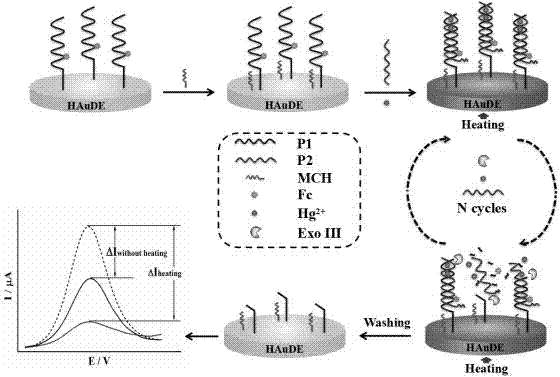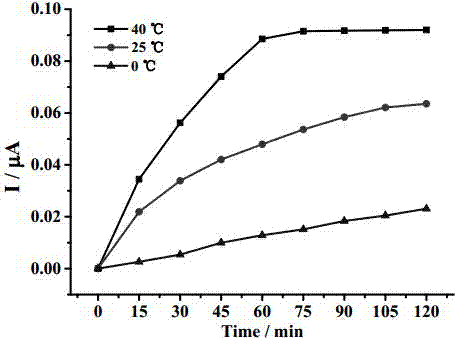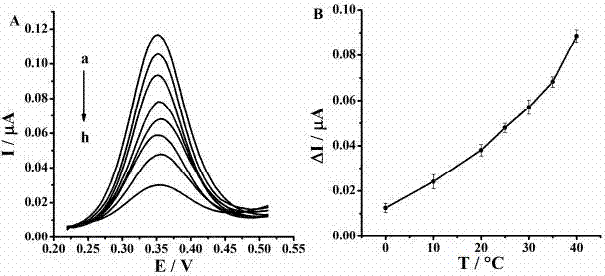Temperature controllable electrochemical mercury ion sensor and preparation method thereof
An electrochemical and sensor technology, applied in the field of nucleic acid detection and biological analysis, can solve the problems of increasing the electrode response signal, denaturing the molecular structure of the enzyme, shortening the sensor time, etc., to increase the electrode response signal, enhance the activity, and improve the detection sensitivity Effect
- Summary
- Abstract
- Description
- Claims
- Application Information
AI Technical Summary
Problems solved by technology
Method used
Image
Examples
Embodiment 1
[0038] A Temperature-Controllable Electrochemical Hg-Based Amplification of Exonuclease III Targeted Cycling Signals 2+ The preparation method of the sensor, such as figure 1 shown, including the following steps:
[0039] (1) Design a signal probe P1 that is labeled with ferrocene (Fc) near the 5', and the complementary presence of the signal probe P1 and the DNA auxiliary probe P2 can recognize Hg 2+ The T-T mismatch structure, in Hg 2+ In the presence, P2 hybridizes with P1 to form a T-Hg 2 +A double-stranded structure with a 3' blunt end of the -T structure. Induces exonuclease III to digest P1, Hg 2+ Released for recycling; thiol at the 5' end of the P1 chain;
[0040] Wherein, the nucleotide sequence of signal probe P1 is: 5'-SH-(CH 2 ) 6 -CCCCA T(Fc)CGCC ACCAG CTTCT-3',
[0041] The nucleotide sequence of the auxiliary probe P2 is: 5'-TGTAG CTGGT GGCGA TCCCA C-3';
[0042] (2) Gold disk thermode on suede with 0.05 mm Al 2 o 3 Polished to a mirror surface, ul...
Embodiment 2
[0046] Reaction time optimization experiment:
[0047] The enzyme digestion cycle reaction time in step (4) of Example 1 was changed to 0, 15, 30, 45, 60, 75, 90, 105, and 120 min. respectively at different electrode temperatures (0 ºC, 25 ºC, 40 ºC) The experiment was carried out, and other reaction conditions were the same as in Example 1; the gold disc thermode modified with the sulfhydrylation signal probe P1 obtained in step (3) of Example 1 was subjected to SWV detection in 10 mM tris-HCl detection solution to obtain the Fc Oxidation peak current I 0(Fc) ; The electrochemical biosensor finally obtained in the embodiment 1 step (4) is detected with SWV in 10 mM tris-HCl detection solution, and the oxidation peak current I of the obtained Fc is Fc with the obtained I 0(Fc) Take the absolute value of the difference: |ΔI Fc |=|I Fc -I 0(Fc) | with |ΔI Fc |Plotted against temperature, such as figure 2 As shown, at the same electrode temperature, it can be seen that th...
Embodiment 3
[0049] Reaction temperature optimization experiment:
[0050] Only change the reaction temperature in step (4) of Example 1, where a is the control group, and the reaction temperatures of b-f are 0, 10, 20, 24, 30, 35, 40 ºC in sequence, and the experiments are carried out separately, and other reaction conditions are implemented at the same time Example 1: The gold disc thermode modified by the signal probe P1 obtained in step (3) of Example 1 was subjected to SWV detection in 10 mM tris-HCl detection solution, and the oxidation peak current I of Fc was obtained 0(Fc) ; The electrochemical biosensor finally obtained in the embodiment 1 step (4) is detected with SWV in 10 mM tris-HCl detection solution, and the oxidation peak current of the obtained Fc is compared with the obtained I 0(Fc) Take the absolute value of the difference: |ΔI Fc |=|I Fc -I 0(Fc) | with |ΔI Fc |Plotted against temperature, such as image 3 As shown, it can be seen that with the increase of temper...
PUM
 Login to View More
Login to View More Abstract
Description
Claims
Application Information
 Login to View More
Login to View More - R&D
- Intellectual Property
- Life Sciences
- Materials
- Tech Scout
- Unparalleled Data Quality
- Higher Quality Content
- 60% Fewer Hallucinations
Browse by: Latest US Patents, China's latest patents, Technical Efficacy Thesaurus, Application Domain, Technology Topic, Popular Technical Reports.
© 2025 PatSnap. All rights reserved.Legal|Privacy policy|Modern Slavery Act Transparency Statement|Sitemap|About US| Contact US: help@patsnap.com



